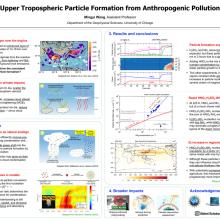Upper Atmospheric Particle Formation from Anthropogenic Pollution
Mingyi
Wang
University of Chicago
Poster
The major remaining uncertainty in climate projections stems from the aerosol-cloud-climate interactions in the atmosphere. Therefore, an accurate representation of aerosol particles and clouds is the foundation of any effort to forecast long-term climate change. Aerosol particles in the upper atmosphere are especially important because they are thought to provide at least one-third of global cloud condensation nuclei (CCN). However, the precursor vapors and associated mechanisms that drive particle formation at altitude are poorly understood.
This talk will first present recent results that fill the knowledge gap on how anthropogenic pollution drives particle formation in the cold upper atmosphere, with experiments performed in the CERN CLOUD chamber. We show that nitric acid, sulfuric acid and ammonia form particles synergistically, at rates orders of magnitude faster than those from conventional ternary H2SO4 nucleation. The importance of this mechanism depends on the availability of ammonia, which was previously thought to be efficiently scavenged by cloud droplets during convection. However, surprisingly high levels of ammonia and ammonium nitrate have recently been observed in the upper troposphere over the Asian monsoon region. Once particles have formed, the co-condensation of ammonia and abundant nitric acid alone is sufficient to drive rapid particle growth to CCN sizes with only trace sulfate. Our model simulations confirm that ammonia is efficiently convected aloft during the Asian monsoon, driving rapid multi-acid HNO3–H2SO4–NH3 nucleation in the upper atmosphere and producing INP that spread across the mid-latitude Northern Hemisphere.
This talk will first present recent results that fill the knowledge gap on how anthropogenic pollution drives particle formation in the cold upper atmosphere, with experiments performed in the CERN CLOUD chamber. We show that nitric acid, sulfuric acid and ammonia form particles synergistically, at rates orders of magnitude faster than those from conventional ternary H2SO4 nucleation. The importance of this mechanism depends on the availability of ammonia, which was previously thought to be efficiently scavenged by cloud droplets during convection. However, surprisingly high levels of ammonia and ammonium nitrate have recently been observed in the upper troposphere over the Asian monsoon region. Once particles have formed, the co-condensation of ammonia and abundant nitric acid alone is sufficient to drive rapid particle growth to CCN sizes with only trace sulfate. Our model simulations confirm that ammonia is efficiently convected aloft during the Asian monsoon, driving rapid multi-acid HNO3–H2SO4–NH3 nucleation in the upper atmosphere and producing INP that spread across the mid-latitude Northern Hemisphere.

Wang-Mingyi-poster.pdf
(3.32 MB)
Meeting homepage
